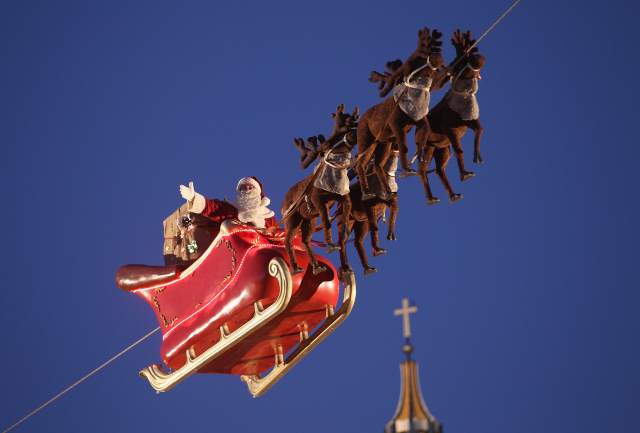One of the enduring mysteries of Christmas is explained, sort of.
December 21, 2016

Those of you who had small children in the late 70s and 80s most likely are familiar with Sesame Street and the Muppets. And especially at this time of year, you likely watched the Christmas specials that this talented and creative group of people produced.
For my two daughters, several of those Christmas specials have become a holiday tradition. By far and away, however, the favorite is Christmas Eve on Sesame Street. In it, Oscar the Grouch plays mind games with Big Bird about how Santa gets down the chimney and how he gets in when there is no chimney available.
That is indeed one of the main questions small children have this time of year. The other is how Santa can span the globe in just one night and deliver all those presents.
Your intrepid reporter has yet to learn the secrets of the chimney. However, Glenn Selk, emeritus Extension animal scientists at Oklahoma State University, has penned his explanation of how Santa’s reindeer can accomplish the task, and he offers it for all to consider every year around this time. Here it is:
Have you ever wondered how Santa's reindeer can make that monumental journey on Christmas Eve? Let's look into some key facts about reindeer that may help us understand how they get Ole St. Nick on his appointed rounds over the world.
First of all, historians report that reindeer have been domesticated by humans for over 5,000 years. Since Santa himself is no spring chicken, we can assume that they have worked together for quite a while. They should not have any trouble finding their way around. There is no need to worry about them getting lost.
We do know that reindeer are ruminants. They are like cattle in this regard. They have four compartments to their stomach. Of course, Santa gets them filled up with hay and moss before he leaves the North Pole, so they should have plenty of feed stored in the four compartments to make it all around the globe. Also, cattle nutritionists have known for years that hay digests more slowly than grain, therefore the big meal that the reindeer eat before the journey should last even longer. Or just like your mom says "It'll stick to their ribs!"
As for drinking water that should be no problem whatsoever. In their homeland, the water is all frozen so they are used to getting the moisture they need by eating snow. So as the sleigh is parked on snowy rooftops in cold weather cities, the reindeer can take on the moisture they need if they get thirsty.
How do they keep warm while flying around on Christmas Eve? The reindeer coat is made of two layers; an outer layer of bristles and an inner layer of dense fur. The fur that they have is very thick and can hold a lot of air. The "blanket" of insulation combining fur and air helps keep them warm in even the coldest of climates. Plus, flying around Christmas night in many areas of the world that are warmer than they have at home should not be a problem.
How do they fly? Well that’s a tougher question, but let’s look at what we do know about them. Reindeer are amazingly fast runners on the ground. University of Alaska researchers report that a newborn baby reindeer at one day of age can out run the fastest graduate student. By the time that they are fully grown it is hard to tell what speeds that they could reach.
Next, remember those huge antlers. Antlers of adult male reindeer can be as much as 4 feet long! Just think about it. Each reindeer has two sets; that’s 8 feet of antlers and with eight reindeer, or nine, if we count Rudolph on foggy nights, that is 64 to 72 feet of total antler span. A typical small Cessna airplane only has about 36 feet of wingspan. Certainly it seems feasible those eight reindeer running that fast with all that antler span could get off the ground.
There are a couple of myths about reindeer that we should clear up. You have probably heard the poem that says that they have tiny reindeer feet. Actually, they have a very wide, large hoof that they use at home to dig through the snow to find grass and moss to eat. You've got to think that those wide hooves would come in handy for sliding to rather sudden stops on the small landing sites that Santa has to work with on Christmas Eve.
And you've probably heard the song about “up on the house top click, click, click.” Well, it is true that reindeer do make a clicking sound as they walk. They have a tendon that snaps over a bone joint and makes a clicking sound on every step.
These are just a few facts about Santa's Reindeer. Maybe this will help us understand that age-old mystery that occurs every Christmas Eve.
You May Also Like



